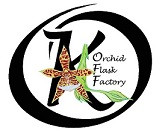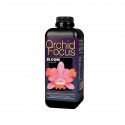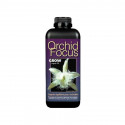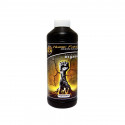2 - Fertilizers - The Program
Fertilizers – The Program
This fertilizer program ensures perfect results for your crops. However, it requires full water management (see the previous lesson).
If you're a beginner, I recommend visiting the tutorial section directly to choose your fertilizer or checking the page orchid-info.org.
This module consists of two parts:
Part 1 – Lesson on composition and general technical information
Part 2 – Tutorial and application
Part 1 - Composition and General Technical Information
Plant Composition and Nutrient Absorption
Plants are composed of approximately 90% water, 10% organic matter (nitrogen, carbon, hydrogen, oxygen), and 1% minerals. These minerals include macronutrients (calcium, magnesium, phosphorus, potassium, sulfur) and trace elements (boron, cobalt, copper, manganese, molybdenum, zinc).
Through photosynthesis, powered by solar energy, plants use their leaves to extract carbon, hydrogen, and oxygen from water and air. Nitrogen and minerals, in absorbable forms, are taken up by the roots depending on their natural environment.
Why Use Fertilizers?
When cultivating orchids, most of the essential nutrients are provided through specialized fertilizers.
Fertilizer Use: Goals and Methods
In cultivation, fertilizers play a vital role by supplying plants with essential nutrients in easily assimilable forms. They can be applied:
- Through the roots: As a liquid during watering.
- Through the leaves: Via foliar sprays.
- In hydroponics: Using enriched circulating water.
-
Fertilizer effectiveness depends on several factors:
- Their composition and concentration.
- The pH (acidity) of the medium.
- Chemical interactions between elements.
- The biological activity of the substrate.
Some elements, such as sodium, chlorine, nickel, and chromium, are also necessary but in trace amounts. Their presence in water or fertilizers is generally sufficient to meet plant needs.
What About Micro-Elements?
The mineral wheel is a model used to illustrate the complementarity and interdependence of nutrients in soils and plants, highlighting the essential micro-elements required for their growth.
The Mineral Wheel and Micro-Element Balance
The mineral wheel emphasizes the balance between these elements: an excess or deficiency of one can disrupt the absorption or availability of others, highlighting the importance of harmonious nutrient management in the soil.
- Iron (Fe): The engine of photosynthesis, helping the plant produce energy. Without iron, it’s as if the plant’s solar panel is malfunctioning.
- Manganese (Mn): Acts as a conductor for photosynthetic enzymes and helps manage oxygen. It prevents “rust” by regulating oxidative stress.
- Boron (B): The cement that strengthens cell walls and guides sugar transport, much like a mail carrier delivering packages.
- Zinc (Zn): Comparable to a key unlocking critical enzymes for growth. Without zinc, biological “doors” remain closed.
- Copper (Cu): Functions like an electrician, facilitating signal conduction and playing a role in lignin production, essential for structural support.
- Molybdenum (Mo): A subtle but vital catalyst, it helps the plant assimilate nitrogen, much like a translator rendering nitrogen usable.
- Chlorine (Cl): Crucial for water balance and gas exchange, akin to a lockkeeper controlling water and nutrient flow.
Can Fertilizers Be Mixed?
Fertilizers contain specific chemical compounds (such as nitrogen, phosphorus, potassium, etc.) that can react when mixed together. For example:
- Some nitrate-based fertilizers can form unstable or toxic compounds when combined with ammonium-based fertilizers.
- Inappropriate mixtures can result in the formation of insoluble deposits, making the nutrients unusable for plants.
Each plant has specific nutrient needs. Mixing fertilizers without adjusting the doses can create an imbalance, with an excess of certain elements (e.g., too much nitrogen) and a deficiency of others (such as potassium or phosphorus). This imbalance can weaken the plants, making them more vulnerable to diseases and pests.
Certain chemicals, when mixed, can produce hazardous gases or exothermic reactions (heat release), which may lead to accidents during preparation or application.
Part 2 – Tutorial and Application
Important Reminders and Information
The dosage should be measured using a conductivity meter on controlled water.
Electrical conductivity (EC) is an electrical measurement that reflects the total amount of dissolved salts in a solution. The more salts the solution contains, the more ions are available to carry electrical charges, which decreases the solution’s resistance. This property is measured with a conductivity meter, with units expressed in MicroSiemens (µS) or millisiemens (mS).
However, some compounds in fertilizers, such as urea, are electrically neutral. Urea, being an organic compound, does not impact the electrical conductivity of the solution. This means that the nitrogen concentration in a fertilizer with a high proportion of urea cannot be precisely determined based on electrical conductivity alone.
For example, the fertilizer Plant Prod (28-14-14), where 80% of the nitrogen is in the form of urea, will show a conductivity of about 300 µS, corresponding to a nitrogen concentration of 125 ppm. By comparison, a fertilizer containing nitrogen in nitrate form would show a conductivity of 650 µS for the same nitrogen concentration.
Caution: The lack of urea's effect on conductivity can lead to the risk of nitrogen overdosing if electrical conductivity is used as the sole indicator to assess the amount of salts in the solution. Therefore, it is crucial to consider the chemical composition of fertilizers when using them.
Where to Find All These Products?
You can find all these products on the website kayorchid.com or soon on there.
Share this content

 Culture in vitro of orchids
Culture in vitro of orchids
 Cultivation Tips for Orchids
Cultivation Tips for Orchids
 Orchid Technical Sheets: Watering, Fertilizing, Substrate, Light
Orchid Technical Sheets: Watering, Fertilizing, Substrate, Light
 About orchids - Good to Know
About orchids - Good to Know
 My Plants
My Plants







By Rose-Marie Mottiaux 11/10/2025 14:23:42
Bonjour, je me demandais si les graines je devait les désinfecter a l'eau avec du hydrogen de peroxide ou autre ? Merci d'avance, bonne journée a vous.
View replies (1) -
By Kay orchid Blog Author 11/11/2025 06:42:57
Bonjour, ça dépend (selon mon expérience). Je recommande majoritairement de l'eau oxygénée modifiée à 10 volumes pour une grande majorité de graines cependant plutot hypochlorite de calcium à 5% pour tout ce qui est paphiopedilum et/ou vandae bonne journée